
The Arthoniales is the second largest order of mainly crustose lichens, but fruticose lichens are present as well. The order contains around 1500 species, while the largest order with lichenized fungi, the Lecanorales, contains more than 14000 species.

The Arthoniaceae are a family of lichenized, lichenicolous and saprobic fungi in the order Arthoniales. The Arthoniaceae is the largest family of Arthoniales, with around 800 species. Most species in Arthoniaceae belong in Arthonia which is the largest genus with 500 species. The second and third largest genus is Arthothelium with 80 species, and Cryptothecia with 60 species.

The Peltigeraceae are a family of lichens in the order Peltigerales. The Peltigeraceae, which contains 15 genera and about 600 species, has recently (2018) been emended to include the families Lobariaceae and Nephromataceae. Many Peltigeraceae species have large and conspicuous, leathery thalli. They largely occur in cool-temperate to tropical montane climates. Tripartite thalli involving fungus, green algae and cyanobacteria are common in this family.

The Pannariaceae are a family of lichens in the order Peltigerales. Species from this family have a widespread distribution, but are especially prevalent in southern temperate regions.
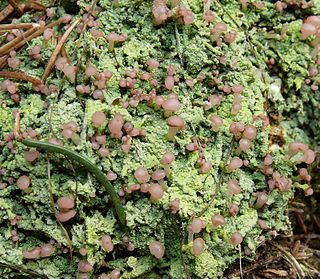
The Baeomycetales are an order of mostly lichen-forming fungi in the subclass Ostropomycetidae, in the class Lecanoromycetes. It contains 8 families, 33 genera and about 170 species. As a result of molecular phylogenetics research published in the late 2010s, several orders were folded into the Baeomycetales, resulting in a substantial increase in the number of taxa.
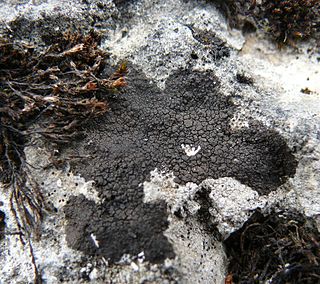
Verrucariaceae is a family of lichens and a few non-lichenised fungi in the order Verrucariales. The lichens have a wide variety of thallus forms, from crustose (crust-like) to foliose (bushy) and squamulose (scaly). Most of them grow on land, some in freshwater and a few in the sea. Many are free-living but there are some species that are parasites on other lichens, while one marine species always lives together with a leafy green alga.

Ochrolechia is a genus of crustose lichens in the family Ochrolechiaceae.
Sagiolechia is a genus of lichen-forming fungi in the family Sagiolechiaceae. The genus was circumscribed by lichenologist Abramo Bartolommeo Massalongo in 1854, who assigned Sagiolechia protuberans as the type species. The family Sagiolechiaceae was proposed in 2010 to contain Sagiolechia as the type genus, and genus Rhexophiale; molecular phylogenetic analysis showed that these two genera formed a distinct clade in the Ostropales.

Absconditella is a genus of lichenised fungi in the family Stictidaceae. The genus was circumscribed in 1965 by Czech lichenologist Antonín Vězda, with Absconditella sphagnorum assigned as the type species. Absconditella is characterised by gyalectoid apothecia with a hymenium that is not amyloid, without a dark pigment and thalli containing green algae as photobionts. The genus name means "hidden", a reference to the scant structure of the thallus and its small apothecia.
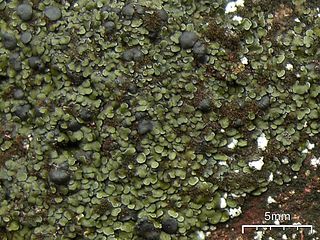
Spilonema is a genus of lichen-forming fungi in the family Coccocarpiaceae. The genus was circumscribed by Jean-Baptiste Édouard Bornet in 1856.

Steinera is a genus of lichen-forming fungi in the family Koerberiaceae. It was circumscribed in 1906 by Austrian-Hungarian botanist Alexander Zahlbruckner, who dedicated the genus name to his friend Julius Steiner, an Austrian teacher and lichenologist. The genus was revised by Aino Henssen and Peter Wilfred James in 1982. In 2017, Damien Ernst and Roar Skovlund Poulsen described some new species, and recombined others into the genus based on a study of the genus in the subantarctic islands of Crozet and Kerguelen.
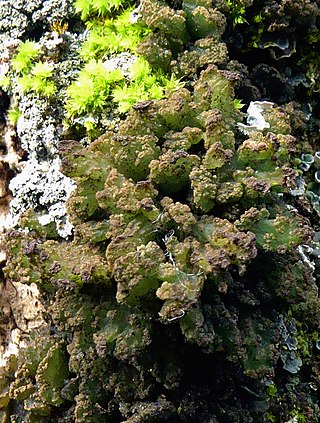
The Arctomiaceae are a family of lichenized fungi in the Ascomycota, class Baeomycetales. The family was named by Theodor Magnus Fries in 1861, with Arctomia as the type genus. Species in this family are found in arctic and subarctic habitats, usually associated with bryophytes.
Arctomia is a genus of lichen-forming fungi in the family Arctomiaceae. The genus was originally circumscribed by Theodor Magnus Fries in 1861. Arctomia has a circumpolar distribution.

The Tephromelataceae are a family of lichenized fungi in the order Lecanorales. The family was circumscribed by Austrian lichenologist Josef Hafellner in 1984. Tephromelataceae comprises the genera Tephromela, Calvitimela, Mycoblastus and Violella, which together constitute a well-supported monophyletic group.

Trapeliaceae is a family of lichens in the order Baeomycetales. The family contains 12 genera and about 125 species.
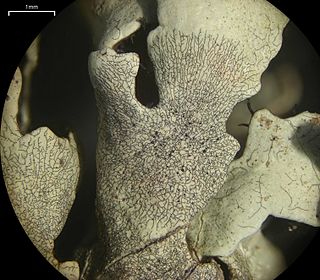
Lichenostigmatales is an order of fungi in the class Arthoniomycetes. It contains the single family Phaeococcomycetaceae. Lichenostigmatales was circumscribed in 2014 by Damien Ertz, Paul Diederich, and James D. Lawrey, with genus Lichenostigma assigned as the type. Using molecular phylogenetics, they identified a lineage of taxa in the Arthoniomycetes that were phylogenetically distinct from the order Arthoniales. Species in the Lichenostigmatales include black yeasts, lichenicolous, and melanised rock-inhabiting species.
Steineropsis is a genus of lichen-forming fungi in the family Pannariaceae. It has two species. The genus was circumscribed by Toby Spribille and Lucia Muggia in 2010, with Steineropsis alaskana assigned as the type species. The type specimen of this lichen was found in Skagway, Alaska, where it was growing on a rock in a snowbed at an altitude of 1,051 m (3,448 ft). The generic name alludes to a resemblance to the genus Steinera. A second species, Steineropsis laceratula, also found in Alaska, was added to the genus in 2020. Molecular phylogenetic analysis showed that Steineropsis has a sister taxon relationship to genus Protopannaria.
Dendriscosticta is a genus of foliose lichens in the family Peltigeraceae. The genus was circumscribed in 2013 by lichenologists Bibiana Moncada and Robert Lücking with Dendriscosticta wrightii assigned as the type species. The genus, a segregate of Sticta, was created to contain species in the Sticta wrightii clade. Dendriscosticta has a sister taxon relationship with the genera Yoshimuriella and Lobariella. Dendriscosticta is distinguished from Sticta by the presence of algae in the excipulum.
Tingiopsidium is a genus of lichen-forming fungi in the family Koerberiaceae. The genus was circumscribed in 1939 by French botanist Roger-Guy Werner, with Tingiopsidium pubescens assigned as the type species. Vestergrenopsis, a genus proposed by Vilmos Kőfaragó-Gyelnik in 1940, was shown to contain a species that is the type of Tingiopsidium, and because Tingiopsidium was published a year earlier, the principle of priority makes Vestergrenopsis illegitimate, and a synonym of Tingiopsidium.
Henssenia is a genus of lichen-forming fungi in the family Koerberiaceae. It has four species. The genus was circumscribed in 2017 by Damien Ertz, Roar Skovlund Poulsen, and Ulrik Søchting, with Henssenia glaucella assigned as the type species. The main distinguishing characteristic of the genus is simple ascospores that sometimes have a plasma bridge. The genus name honours German lichenologist Aino Henssen.













